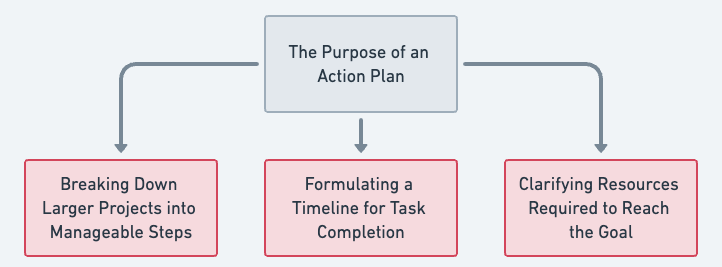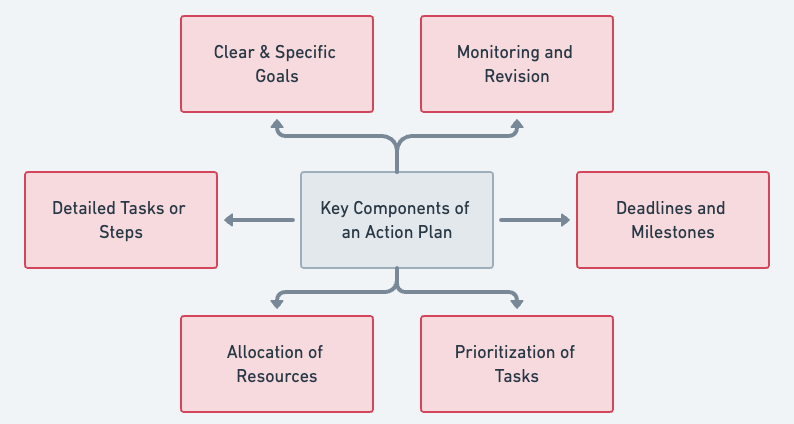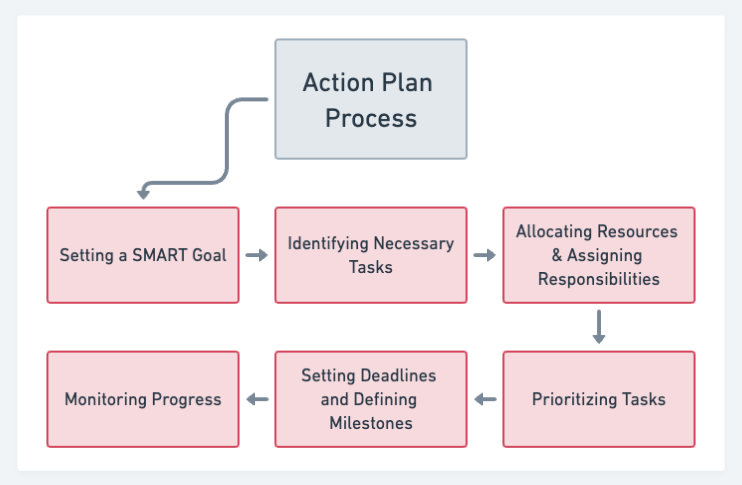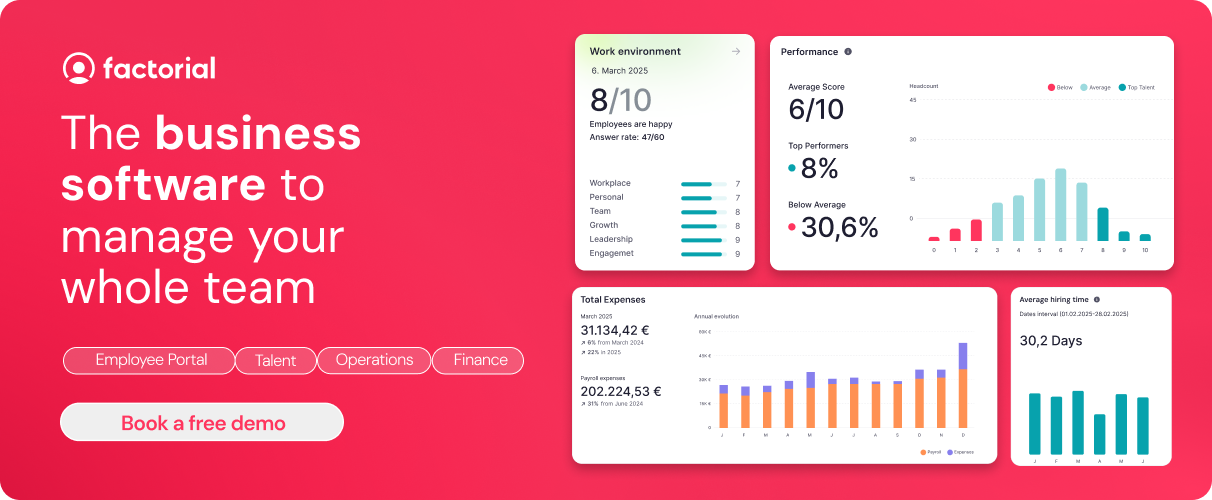30-sec summary:
What is the secret of transforming a vision into a reality?
Is there a structured approach to breaking down complex goals into manageable tasks?
How do businesses and individuals ensure they’re using resources effectively?
When faced with challenges, how can one make sure their plan remains flexible and effective?
Read this article to find the answers and learn how an action plan really works.
TABLE OF CONTENTS
- The Purpose of an Action Plan
- Key Components of an Action Plan
- The Process of Creating an Action Plan
- Differences Between Various Plans
- Implementing an Action Plan Successfully
- Examples of Action Plans
- Use This HR Software To Manage Your Team ✅
The Purpose of an Action Plan
People and organizations use action plans to get to where they want to go. It’s more than just planning; it’s about efficiency, clarity, and a systematic way to achieve goals:

Clarifying Resources Required to Reach the Goal
Action plans prevent unexpected roadblocks, whether it’s a lack human, financial, or technological resouces. It also fosters trust among stakeholders, since they can see a clear allocation of resources, making sure everything is on track.
Formulating a Timeline for Task Completion
A project’s time is often the most important thing. An action plan details when each task should start and end, so everyone knows what’s going on. If the timeline’s clear, it doesn’t just keep everyone on track, but also makes sure stakeholders know what’s going on. In the end, a well-defined timeline reduces delays and ensures tasks are done on time.
Breaking Down Larger Projects into Manageable Steps
Creating an action plan allows you to break down big projects into smaller, more manageable tasks. This step-by-step approach makes sure that each task gets the attention it deserves, and complexities are handled easily. Additionally, it makes sure each phase of the project goes smoothly and efficiently.
| Factorial Insight: Only 8% of managers say they can ensure that strategic priorities are translated into the necessary actions at the front line. |
Key Components of an Action Plan
Using an action plan, you can turn your vision into actionable tasks, ensuring systematic progress towards your goals. Here’s what it looks like:

Clear and Specific Goals
Any action plan’s goal needs to be clear and specific, so it gives you a direction to follow. Ambiguity can lead to confusion, so it’s important to define these goals clearly, so there’s no room for misinterpretation.
Detailed Tasks or Steps
Having set the goals, it’s time to break them down into actionable steps. These steps are the building blocks for the action plan, ensuring everything is covered. Individuals and teams get a clear roadmap on what to do and when, so they know what to do.
Allocation of Resources (team members, budget, equipment)
Tasks need resources to be executed effectively. This part of the action plan shows how to allocate them. This section makes sure that every task has everything it needs to be successful, whether it’s assigning team members to specific tasks, setting budgets, or getting the right equipment.
Prioritization of Tasks
In order to manage time efficiently and ensure the most impactful tasks get the attention they deserve, prioritizing tasks ensures critical ones are addressed first.
Deadlines and Milestones
Timebound action plans are time-bound. Setting deadlines ensures each task gets done on time, and milestones make sure everything’s on track. Teams use milestones as a way to recognize and celebrate achievements and measure how far they’ve come.
Monitoring and Revision Mechanisms
During execution, there might be adjustments needed. This component makes sure there’s a way to keep an eye on the progress of the action plan and to make necessary changes. It keeps the plan relevant and effective, even if something unexpected happens.
| Factorial Insight: Companies that align their goals, strategic plans, and action initiatives have 12% higher probability of achieving their strategic objectives. |
The Process of Creating an Action Plan
Action plans are a systematic process that takes thought, research, and collaboration. It’s about turning abstract goals into concrete steps, ensuring a clear path to success.

Setting a SMART Goal (Specific, Measurable, Achievable, Relevant, Time-bound)
SMART criteria ensure that the goal is well-defined and realistic. They set out what needs to be done, how success will be measured, and when it needs to be accomplished.
Identifying Necessary Tasks
After you have a clear goal in mind, the next step is to identify the tasks that need to be done to accomplish it. Each task should be clear and specific, so there’s no ambiguity.
Allocating Resources and Assigning Responsibilities
It takes resources, whether they’re human, financial, or material, for every task. Here, we must determine what resources are needed and ensure they’re available. We also assign responsibilities, so everyone knows what their role is and what to expect.
Prioritizing Tasks Based on Importance and Sequence
In order to make sure resources are used efficiently and tasks are completed in the right order, prioritizing tasks ensures that critical activities are addressed first.
Setting Deadlines and Defining Milestones
Setting deadlines ensures accountability and timely completion of tasks. Also, defining milestones gives teams a way to assess progress, celebrate accomplishments, and stay motivated along the way.
Monitoring Progress and Making Necessary Adjustments
The action plan needs to be monitored as it gets executed. This involves checking how tasks are being done and assessing the quality of the work. In case there’s a discrepancy or a problem, we adjust the plan.
| Factorial Insight: 61% of executives admit they struggle to bridge the gap between strategy formulation and its day-to-day implementation. |
Difference Between Actions Plans & Other Plans
Various types of plans serve different purposes, but their objectives, structures, and applications can vary a lot. Here’s how they differ.
Action Plan vs. Plan B (Contingency Plan)
- Action Plan: The roadmap breaks down the goal into actionable steps, sets timelines, allocates resources, and defines responsibilities to accomplish the goal.
- Plan B (Contingency Plan): The backup plan is foreseeing potential risks and coming up with strategies to mitigate them.
- Key Difference: Contingency plans are reactive, designed for unforeseen challenges, while action plans are proactive and focused on achieving a goal.
Project Plan vs. Action Plan
- Action Plan: Describes how to accomplish a particular objective within the bigger project, and it’s a subset of the project plan.
- Project Plan: This document outlines everything about the project, from its initiation to its completion. It includes objectives, scope, budget, timelines, risks, and stakeholders.
- Key Difference: Action plans focus on specific tasks or objectives within the project, while project plans give an overview.
Action Plan vs. To-do List
- Action Plan: This document breaks down a goal into tasks, allocates resources, sets deadlines, and prioritizes.
- To-do List: A list of things that need to be done, with no breakdown of resources, timelines, or priorities.
- Key Difference: Action plans are comprehensive and strategic, while to-do lists are basic and lack the depth and structure of plans.
Discover Business Management Software that helps your team do more.👇

Implementing an Action Plan Successfully
A well-crafted action plan is only half the battle; its implementation determines if you meet your goals. In order to execute an action plan successfully, you need a combination of tools, strategies, and proactive measures. Here’s how to do it:
Utilizing a Management Software
Teams can track progress, assign tasks, set deadlines, and collaborate in real-time with a management software, which allows them to establish goals, track progress, assign tasks, and set deadlines. With platforms like Factorial HR, you can help your team succeed.
Using Templates for Consistency and Efficiency
Templates provide a standardized structure for action plans. By using templates, teams can make sure every action plan keeps a consistent format, so they’re easier to understand and execute. Templates also save time, because teams don’t have to start over every time.
Setting Up Real-time Alerts and Dependencies
A real-time alert lets team members know when deadlines are, so they’re on time. Dependencies, on the other hand, make sure tasks go in the right order. For example, if Task B depends on Task A, team members will be reminded to finish Task A before moving on.
Checking Off Completed Tasks
Checking off completed tasks gives you a sense of accomplishment. Not only does it boost morale, but it gives you a clear visual representation of your progress. Plan to regularly update your action plan to ensure everyone knows what’s been accomplished and what still needs to be done.
Addressing and Discussing Any Delays or Issues Promptly
It’s inevitable that there’s going to be challenges in every project. The key is to deal with them right away. If there’s a delay or an issue, talk to the team right away. When you work together on problems, you’ll come up with innovative solutions, and you’ll stay on track despite obstacles.
| Factorial Insight: Only 34% of U.S. workers strongly agree that they have a clear plan for their tasks, but those who do are 2.5 times more likely to be engaged in their jobs. |
Examples of Action Plans
There are many kinds of action plans. They serve as structured roadmaps that help people and teams reach specific goals. Here are a few examples:
Business Action Plan
- Objective: Expand business operations to another region within the next year.
- Tasks: Market research, securing funding, hiring local staff, finding a suitable location, and launching a marketing campaign.
- Resources: Research team, financial advisors, HR team, and marketing professionals.
- Timeline: 12 months with monthly milestones.
Marketing Action Plan
- Objective: Increase brand awareness by 30% over the next six months.
- Tasks: Conducting a SWOT analysis, identifying target audience segments, creating a content calendar, launching ad campaigns, and monitoring engagement metrics.
- Resources: Marketing team, content creators, ad budget, and analytics tools.
- Timeline: 6 months with bi-weekly check-ins.
Sales Action Plan
- Objective: Boost sales by 20% in the upcoming quarter.
- Tasks: Identifying potential leads, training sales team on new strategies, offering promotional discounts, and gathering customer feedback.
- Resources: Sales team, CRM software, training materials, and feedback forms.
- Timeline: 3 months with weekly sales targets.
Personal Development Action Plan
- Objective: Improve leadership skills over the next year.
- Tasks: Attending leadership workshops, reading relevant books, seeking mentorship, and taking on challenging projects.
- Resources: Workshop fees, reading materials, mentor’s time, and real-world projects.
- Timeline: 12 months with quarterly self-assessments.
Test Your Knowledge about Action Plans With This Quiz!
True
False
True
False
True
False
True
False
True
False



